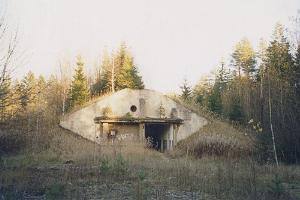Kadila and Rohu Missile Bases Military town
Loading...
59.1878,26.3463
Raeküla, Vinni vald, Lääne-Viru maakond, Eesti / Avispea, Väike-Maarja vald, Lääne-Viru maakond, Eesti, Estonia, Lääne-Virumaa
+372 5263831
Guide: Väike-Maarja Museum Friends Society

This missile base is situated around 10 km from the small borough of Väike-Maarja.
It formed part of the nuclear missile base established in Rakvere during the Soviet era. The base was operated from Rakvere during the 1960s and 1970s. It was closed in 1978, having been depreciated.
What remains today is mostly in ruins. Some of the missile, maintenance and storage hangars and landing fields are still intact.
















In the 1960s and 1970s, the 304th Rocket Regiment of the Soviet Union Guards (s/o 14372) was located in the city of Rakvere on the Arkna road, and two divisions were subordinate to it, one in Kadila and the other in Rohu-Lebavere forests. In this base, there was a division servicing the R-12 type missiles put into service in the Soviet Union in 1959. These missiles were capable of flying at a distance of 2 thousand kilometers, carrying a thermonuclear warhead with either a power of 1 or 2.3 megatons (1 mgt = 1 million tons). The territory where the division was located was surrounded by a double barbed wire fence. Between the two fences was a wire mesh connected to a high-voltage current. When a person or an animal touched the fence, a signal system was activated to indicate the point of contact. There were machine gun emplacements in the gate. The rocket units located in the forests were called artillery divisions. People didn't know there were nuclear missiles in the woods around here. There were different zones in the territory of the division. In the first zone were the working rooms of the guard team and officers, headquarters, ammunition warehouses, underground fuel tanks, machine garages. The officers lived in Rakvere in the district intended for the military. In the second zone there were soldiers' barracks, a sauna, a laundry, a canteen, a club, a boiler house, and a power station. There were food warehouses, garages with machines, fuel oil storage in the economic yard. Battle zone - the most important thing in the base. It was in turn separated from other zones. In the combat zone there was a special rocket fuel storage, an assembly area, hangars for missiles and their service, launch pads. One division had 4 missile hangars. There was one hangar and one launch pad for two rockets. 6 missiles could be launched immediately if necessary, 2 were in reserve. The missiles were in a horizontal position on wheeled bases in the hangar. The length of the rocket including the warhead was 22.1 m. The warehouse had to have a uniform temperature (+4ºC) and humidity both in summer and winter. An automatic ventilation system worked to obtain a permanent microclimate. Warm air came from the boiler room in the hangar through pipes. Both parts of the base located in the woods here were the same. Only Rohus (Lebaveres) was a repository for nuclear warheads, a shooting range, and a pigsty for both divisions. The locators near the Kadila division served both the Kadila and Rohu bases. The base facilities remain in ruins. When the base was empty, the existing buildings were used as construction material by both collective farms and private individuals. There are almost 5 hangars on the territory of the Rohu base: 2 for storing nuclear charges, 2 for missiles and a hangar serving them. A "painting" with a picture of Lenin still adorns the wall of the latter. From the first of the rocket hangars, the road leads to the launch pad. On the strong concrete base, the ring where the rocket preparing for launch was attached was clearly visible until recently, before the looting by metal thieves. In one of the storage-hangars, you can see the massive doorknob of the room for storing nuclear charges (also looted), to which a door up to half a meter thick was once attached. At the Kadila base, the hangars for the storage of special fuel have remained almost intact, and at the end of the base there is a rocket hangar, from which the road leads to the launch pad. The strong concrete base had a circle, just like the Rohu base. In the distance, the ramparts of the launch pad can be seen, the place where the rocket was hidden during the launch is still a shadow. The service hangar is also "intact" nearby. Servicing the rockets located here was difficult and troublesome. In ten years, the base was morally obsolete. The mentioned military unit was liquidated in the second half of 1978. Underground shafts and more advanced launchers were built for the new mobile missile systems. The new type (R-12U) missiles were much faster to service and more difficult to detect.